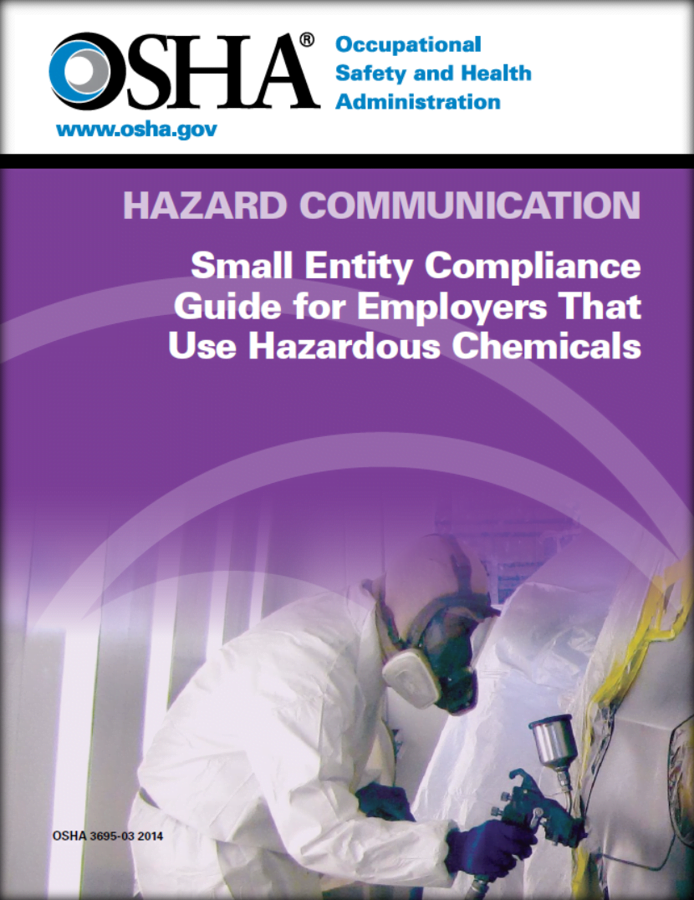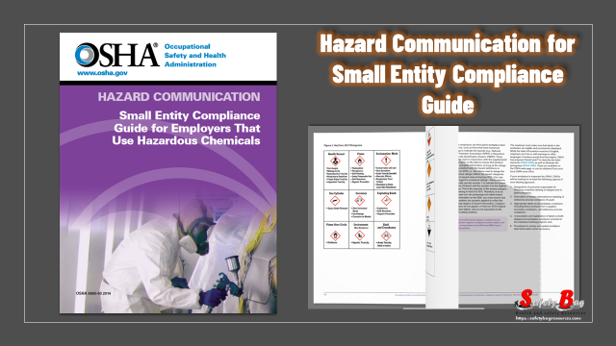
Hazard communication for small Entity Compliance Guide for Employers that use hazardous chemicals
This guide is intended to help small employers
comply with the Occupational Safety and Health
Administration’s (OSHA) Hazard Communication Standard (HCS). The guide is advisory in nature and informational in content. It is not itself a standard or regulation, and it creates no new legal obligations. The employer must refer to the appropriate standard to ensure it is in compliance. In 25 states and two territories, OSHA standards are enforced by the state agency responsible for the OSHA-approved state plan. ( Read: Preparing for Hazcom Update )
This guidance document is not a standard or regulation, and it creates no new legal obligations. It contains recommendations as well as descriptions of mandatory safety and health standards. The recommendations are advisory in nature, informational in content, and intended to assist employers in providing a safe and healthful workplace. The Occupational Safety and Health Act requires employers to comply with safety and health standards and regulations promulgated by OSHA or by a state with an OSHA-approved state plan. In addition, the Act’s General Duty Clause, Section 5(a)(1), requires employers to provide their employees with a workplace free from recognized hazards likely to cause death or serious physical harm.
Read the Hazard communication book by Flipping the File below :
Also Read: Hazard Identification Plan (HIP) Template
Chemicals have become an important element of almost every aspect of modern life. All of these chemicals from cleaning fluids to pharmaceuticals, pesticides, and paints are produced in workplaces and may be used in workplaces downstream. While these chemicals have utility and benefits in their applications, they also have the potential to cause adverse effects.
These adverse effects include both health hazards (such as carcinogenicity and sensitization), and physical hazards (for example, flammability and reactivity properties). In order to protect workers
from these effects—and to reduce the occurrence of chemical source illnesses and injuries, employers need information about the hazards of the chemicals they use, as well as recommended protective measures. Workers have both a right and a need to know this information too, especially so that they can take steps to protect themselves when necessary.
No one knows exactly how many chemicals may be present in American workplaces. The total number of chemical substances that have been developed and registered in the Chemical Abstracts Service Registry reached 60 million in 2011—the last 10 million of those were added in less than two years.
Many of them involve innovations such as the application of nanotechnology. While not all of these chemicals are produced commercially today, this vast number indicates the scope of the potential problems in workplaces with regard to the safe use of chemicals. In addition, most chemical substances are formulated into mixtures for use in the workplace. Therefore, the number of unique chemical mixtures is far greater than the number of substances, and most workers are exposed to mixtures.
The Content of the Hazard communication for small Entity:
- Introduction
- II. Steps to an Effective Hazard Communication Program
- Learn the Standard/Identify Responsible Staff
- Prepare and Implement a Written Hazard Communication Program
- Ensure Containers are Labeled
- Maintain Safety Data Sheets
- Inform and Train Employees
- Evaluate and Reassess Your Program
- III. Conclusion
- Appendix A: Sample Written Hazard Communication Program
- Appendix B: Quick Guide to Hazard Communication Training Workers’ Rights
- OSHA Assistance, Services, and Programs
- NIOSH Health Hazard Evaluation Program
- OSHA Regional Offices
- How to Contact OSHA
( Also Read : Books: CAL/OSHA Pocket Guide for Construction Industry )
Download The Book
OSHA-Hazard communication for small Entity
More Downloads
- Books: How to Plan for Workplace Emergencies and Evacuation
- Books: Firefighting Precautions at Facilities with Combustible Dust
- Books: A Guide to Electrical Safety
- Books: Preventing Falls in Scaffolding Operations
- Handbook: Worker’s Safety
- Books: A Guide to Safety in Confined Spaces
- Books: OSHA-Hazard communication for small Entity
- Books: OSHA-Permit Required Confined Spaces
- OSHA: Underground Construction (Tunneling)
- OSHA Recommended Practice of Health and Safety programs in construction
- Books: OSHA-Is it Safe to Enter Confined Space?
- Books: General Industry Digest
- Books: A Guide to Bloodborne Pathogens in the workplace
- Books: 5-Minute Workplace Safety Talks
- CAL/OSHA Scaffold Guide for safe use of supported Scaffolds
- Books: CAL/OSHA Pocket Guide for Construction Industry
- Books: Let’s Talk Safety
- Books: OSHA Fall Protection Toolbox Talks and Trainer Guide
- Tool Box Talk: Don’t Let Chemicals Get to You
- Tool Box Talk: Hand Grinder Safety
- Tool Box Talk: Lockout and Tagging
- Tool Box Talk: Winter Driving Safety Tips
- Tool Box Talk: Working Around Heavy Equipment
- Tool Box Talk: Rotary Hammers-Hammer Drills
- Tool Box Talk: Carbon Monoxide Poisoning
- Tool Box Talk: Boom Truck Safety
- Tool Box Talk: Biohazard Safety

